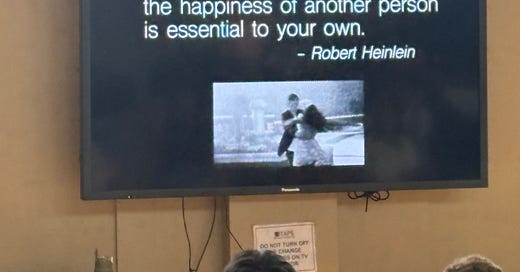the art of social dance
if you were looking for a reason to take (or not take) social dance this is your sign
I’ve quit almost every 1 unit activity class I’ve taken at Stanford. I dropped Beginner’s Golf after two weeks (despite haggling my way in) because I was bored. I didn’t bother showing up for the first day of painting once I saw the waitlist.
But after seeing some of my friends (@Catherine @Albert) take Social Dance—Stanford’s introductory ballroom dancing course—in the fall with glowing reviews, I decided to take a chance. And I fell for it. Hard.
I didn’t realize how much I had missed consistent dance in my life after stopping dancing competitively with the Stanford Bhangra (Indian dance) team. But this bi-daily, pre-lunch hop around the room gave me something I didn’t expect: a new way of being part of the Stanford community.
My middle name Rani, in Tamil means queen and this kind of dance, in its silly and sincere way, made me feel a little like one. Not every class was riveting. But I’m telling you, 50 minutes can hold a lot of life lessons. With that:
7 reasons you should take Social Dance:
1. You abandon social anxiety.
Every 30 seconds, you’re rotating partners, saying hi, introducing yourself, getting all up in someone’s personal space—sometimes in intimate dances like tango or bachata. You stop wondering, Do I smell weird? Am I sweating? and instead start focusing on your partner. And that shift—away from yourself—is really freeing.
2. You learn to prioritize someone else.
The magic happens when you stop obsessing over how you’re doing and start wondering if your partner is having fun. The secret hack? If you’re enjoying yourself, chances are they will too.
3. You meet parts of campus you didn’t know existed.
I met people in my own year who I had truly never seen before (this coming from the girl who gave out business cards freshman year). We became friends, went to the Viennese Ball together, waved at each other on campus. It made this sprawling, segmented place feel smaller. And honestly, dancing in circles forced me to re-learn how to remember names again.
4. It’s actually useful.
Just last week in Mexico City, I found myself teaching my friends salsa and bachata. I get to say I know basic waltz. I can hold rhythm. I now have a weirdly elegant party trick.
5. It makes you feel graceful.
Posture matters. How you carry yourself changes how people see you—and how you see yourself. Dancing with a partner, upright and grounded, reminded me to keep my core tight and my chest open (almost like hearing the voice of my classical dance guru in my head). You start to move differently.
6. It’s creative—and humbling.
As a follow, Social Dance was an exercise in letting go. With one person clearly in charge, the dynamic is a struggle. For leads, it’s creatively think. For follows, it’s listen. Both require trust.
7. You learn from others, without needing to compare.
Like swimming, you do best when you focus on what’s ahead of you. But as Richard Powers likes to say, “Fake what you thought you saw.” It’s now something I use in the dance classes I teach myself. You look around for inspiration, not comparison. You’re never really lost—you’re just improvising.
Are you convinced? Maybe this pushed you the other direction.
Honestly, the dance part of Social Dance is clumsy, well-meaning, and full of mistakes.
But that’s kind of the point.
It’s not about dance at all. It’s about the social part.In a college experience that constantly teaches us to think about ourselves—our performance, our goals, our next step—Social Dance gently says: what if you thought about someone else for once? Or at the very least, what if you thought about yourself in relation to someone else?
Marcus Aurelius wrote, “In a sense, people are our proper occupation. Our job is to do them good and put up with them.” That’s Social Dance.
And one reframing I’ve come to love: acting like a Rani—might not be about how you carry yourself. It’s about how you treat others. With respect, with kindness, with attentiveness. With grace.
—DG






Gotta get the Aurelius quote in